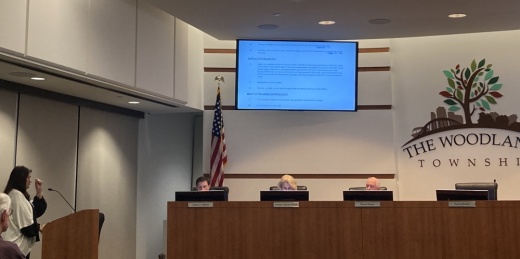The task force has focused on working with various other agencies to facilitate discussions on water and drainage issues in the community.
Bruce Rieser, vice chair of the board of directors and chair of the task force, said it had served its purpose and did not necessarily need to be extended. Among the accomplishments he listed for the task force were getting a local representative, Neil Gaynor, into the membership of the San Jacinto Regional Flood Planning Group as a voting member and seeing an engineering plan get underway for water detention along Spring Creek.
“I think we have to acknowledge the fact that even though we have spent a lot of time talking about subsidence, we are pumping more [groundwater] than we have in the last five years and we don’t control that,” Rieser said. “I am concerned we are creating a committee that people come to and expect some results, and frankly we have no jurisdiction to have those things happen."
Rieser said he believes more can be done by the entities with more direct control over water issues in the region such as Lone Star Groundwater Conservation District.
“In the end, Lone Star [Groundwater Conservation District] decided...to essentially leave the DFCs unchanged,” Rieser said, referring to the desired future conditions voted on by Groundwater Management Area 14 on Jan. 5. The desired future conditions are for the Gulf Coast Aquifer System for the next five years. The conditions include a subsidence metric, as subsidence—ground sinkage—has been tied to groundwater withdrawal. However, the metric is optional.
Director Ann Snyder disagreed, saying she felt the task force should continue, and that it was important to residents of the community and valued by other entities that engage with water issues.
“Things sometimes take time,” Snyder. “One of our most priceless and important assets that we have is water, and for us not to take a stand on that and share the importance of it ... I’d like to see us continue the One Water Task Force.”
The One Water Task Force emerged from a previously formed drainage task force that was created after high-water events in April and May 2016. In 2020, the task force was expanded to include topics such as groundwater and subsidence.
Other board members, including Shelley Sekula-Gibbs who has served as vice chair of the task force, agreed and said the task force could be reconstituted if necessary, if it is not renewed.
Several individuals spoke in the public comment section of the meeting on the topic, indicating support to keep the task force.
Neil Gaynor, the upper watershed representative to the Region 6 San Jacinto Regional Flood Planning Group, spoke at the meeting in support of maintaining the task force.
“Extending the task force will send messages The Woodlands wants to clearly engage in the challenges of flooding and subsidence ... if the board doesn’t send it, the opposite message will be sent,” he said.
Resident Mark Meinrath also spoke at the meeting, stating that he has seen a relationship between measurable subsidence and fault line activity on his property. He said his house is sinking at the rate of about a half-inch a year.
“If GMA-14 has their way my house will be standing on concrete pier you’ll be able to see from the street,” Meinrath said, referring to the new desired future conditions.
Grogans Mill Village Association President Bruce Cunningham also noted support for the One Water Task Force.
“The problems Mr. Meinrath described are real,” Cunningham said. “The next rainstorm may prove them more real than you think.”
Township board members decided to table the matter to do more research on whether the task force could continue without a board member serving as chair of the group.





